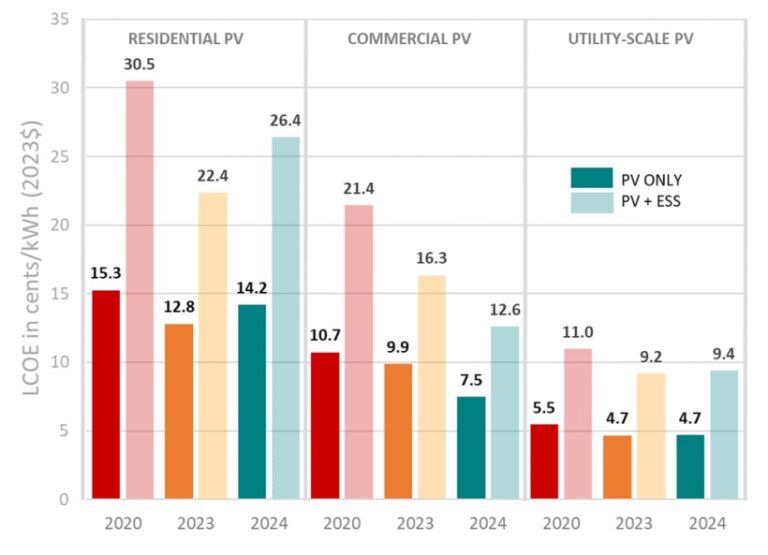The latest solar cost model from the U.S. Department of Energy shows that residential solar prices have increased, commercial solar is becoming cheaper and utility-scale prices are remaining flat. The addition of batteries increases costs by $1.75/W for residential projects and $0.75/W for larger installations.
The U.S. Department of Energy’s Solar Energy Technologies Office (SETO) has released an update Cost model for PV systems for 2024 (PVSCM) data, revealing shifting price trends in the solar industry. Residential solar prices are up, commercial prices are down, and utility-scale prices remain flat.
The report indicates that the Minimum Sustainable Price (MSP), without incentives, for large-scale, agrivoltaic and residential solar projects costs $0.98/Wdc, $1.34/Wdc and $2.74/Wdc, respectively. The Modeled Market Price (MMP) for the same systems is 14%, 12% and 15% higher than the MSP.
SETO defines MSP as the minimum price a company can charge in a balanced, competitive market while remaining financially solvent in the long term. MMP, on the other hand, represents the actual market price under current conditions.
SETO also calculated the levelized cost of electricity (LCOE) based on the MSP data across multiple US regions with varying solar yields. These MSP values, without state or federal incentives and averaged based on weather variations, translate to an LCOE of $0.047/kWh for utility-scale solar, $0.075/kWh for agricultural voltaics, and $0.142/kWh for residential solar. Adding batteries increases the LCOE for each system, by 240 MWh for utilities, 6 MWh for agrivoltaic systems, and 13.5 kWh for residential systems, roughly doubling costs in each case, again before incentives.

LCOE for representative systems installed in an average US climate without deductions for federal, state or local incentives. Source: SETO. While the LCOE values generally show a downward price trend, the data shows more nuance as SETO continues to refine this calculation.
For example, the residential LCOE showed a sharp decline between 2020 and 2023, followed by an increase in 2024. This contrasts with actual price developmentslikely due to evolving methodologies as hardware costs, especially for solar panelshave continued to decline. pv magazine USA has contacted the DOE for comment. Similarly, commercial prices appear to be showing a smooth development, but this also includes a shift from standard commercial ground-mounted systems to agrivoltaic systems. Utility-scale prices have remained more consistent, with only a slight increase in 2024.
SETO also has the PVSCM cost modeling toolthat provides a detailed cost overview for system components. This tool provides insight into the cost structure of things like solar panels, helping the industry better understand changing market dynamics.

In total, SETO released four files: a pricing data file for residential, commercial and utility systems, along with the PVSCM tool used to analyze the data. The residential energy storage tab breaks down the cost of batteries, including components such as cells, packs, enclosures, AC-DC converters, labor, profit, and shipping, among other factors.
A representative of the Department of Energy (DOE) confirmed this annually Benchmarks for costs of solar photovoltaic systems and energy storage in the US will no longer be published. The press release contained links to several historical documentsand a summary of historical prices, including the latest data release, is expected in six months.
This content is copyrighted and may not be reused. If you would like to collaborate with us and reuse some of our content, please contact: editors@pv-magazine.com.
Popular content



